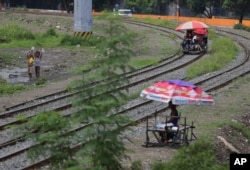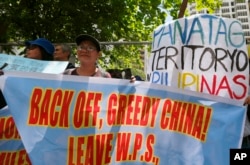Closer relations with a once-distrusted China gave the Philippines another boost this week as Beijing pledged a round of investment for the developing Southeast Asian country and new ideas for maritime security.
When Chinese President Xi Jinping met Philippine counterpart Rodrigo Duterte in China Tuesday, the host offered $73 million in economic and infrastructure aid, while nine Chinese companies signed letters of intent to explore $9.8 billion in business in the Philippines, Manila’s presidential office spokesman Harry Roque said in a statement.
Those are the latest dividends from a 2-year-old friendship between Asia’s biggest economy and the relatively impoverished Philippines, experts in Manila say. The two sides stood divided before 2016, under Philippine ex-president Benigno Aquino, because of a maritime sovereignty dispute.
China pledged a total of $24 billion in aid and investment for the Philippines in October 2016 as the two sides lay the foundation for warmer ties. It has helped build railways and fight Muslim rebels in the ever-restive southern Philippine island Mindanao.
“If you’re talking about the sense that things are actually getting better in the Philippines, as far as the economy is concerned, these are all to a certain extent being attributed to Duterte’s attempts to actually make our relations with China better than they were during the Aquino administration,” said Herman Kraft, political science professor at the University of the Philippines Diliman in Metro Manila.
Straight-forward meeting
Two years ago Filipinos chafed when their newly elected president began pursuing a friendship with China. Aquino had resisted Beijing’s presence in the South China Sea that both countries claim sovereignty over.
A 2012 standoff over the sea’s Scarborough Shoal led to anti-Philippine boycotts in China and world court arbitration filed by Manila. The court favored Manila in mid-2016.
Duterte has maintained popularity among Filipinos partly by getting aid from China for his government’s $169 billion effort to build new infrastructure and stoke the economy.
Duterte met Xi on the sidelines of the annual Boao Forum for Asia in China.
“I guess everyone’s watching, because these potential investments could further speed up activity, economic growth, create more jobs,” said Jonathan Ravelas, chief market strategist with Banco de Oro UniBank in Metro Manila.
China’s investments announced this week will create jobs for 10,000 Filipinos, the presidential website said Friday. Deals cover “large tourism projects,” land reclamation for development and construction of a liquefied natural gas receiving terminal, the website says.
Stronger overall relations
China has relaxed its activity around Scarborough Shoal, and the two sides are in discussions for joint oil exploration in the sea they dispute. Xi and Duterte agreed Wednesday to “strengthen communications” as a way of avoiding accidents in the disputed sea, the Philippine president’s spokesman said.
Duterte received a 70 percent satisfaction rating in the first quarter of 2018, Metro Manila-based research institution Social Weather Stations found. That figure is down one percentage point from December.
“I think he has made a choice to seek alignment and cooperation with China for the foreseeable future under his term,” said Yun Sun, East Asia Program senior associate at the Stimson Center think tank in the United States. “He has been rewarded by China for it. I also think his domestic position, which is relatively strong, has made it possible for him to pursue this policy course.”
Multicountry foreign policy
Duterte has courted Japan as well for investment, and relations with former Philippine colonizer the United States began improving late last year after a slump following Duterte’s election.
“I think he’s trying not to portray a very pro-China position,” said Ramon Casiple, executive director of Philippine advocacy organization Institute for Political and Electoral Reform. “He doesn’t want to be seen as aligned.”
But Filipinos generally trust the president’s engagement with China, he said.
Philippine officials would welcome an extra heavy share of investment from China to cover a historic shortfall of foreign investment, said Rahul Bajoria, a regional economist with Barclays in Singapore. The two sides might work more together on Chinese tourist arrivals following a “decent surge” already, he said.
Direct investment inflows reached an all-time high of $10.05 billion last year, up 21.45 percent from 2017, Philippine news outlet Rappler.com said. It cited money from China and Japan a sources of sustained investment growth in early 2018.
“Incrementally, I think the government’s focus on the Philippines is to get more money in through the FDI route because FDI in the Philippines is generally a lot lower compared to the rest of Southeast Asia, so they won’t really mind if China’s interested in doing more rather than less,” Bajoria said.









